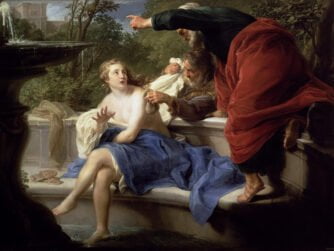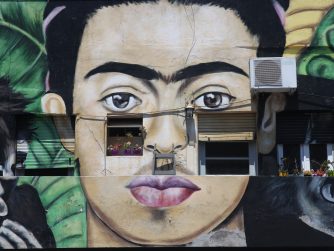Voice 1
Welcome to Spotlight. I’m Colin Lowther.
Voice 2
And I’m Alice Irrizary. Spotlight uses a special English method of broadcasting. It is easier for people to understand, no matter where in the world they live.
Click here to follow along with this program on YouTube.
Voice 1
Zhao Xiaoyong dips his brush into a patch of oil paint. Then, he takes the brush and carefully touches it to the surface of the painting. The painting is of a group of yellow flowers. Normally, these sunflowers are a symbol of happy things. But here, the flowers hang down. It is as if they are as saddened as the painter himself.
Voice 2
Xiaoyong is not making his own work. Instead, he is copying a painting. It is by the famous artist Vincent Van Gogh. Copying Van Gogh has become Xiaoyong’s life work. It is his business. Together, he and his family have made thousands of Van Gogh paintings. They sell them to people all over the world.
Voice 1
Xiaoyong’s work may seem unusual. But he and his family live in Dafen Oil Painting Village in China. In Dafen, thousands of other painters copy work by famous artists as well. They spend much of their lives with Western artists who not famous in China.
Today’s Spotlight is on Dafen Oil Painting Village.
Voice 2
Dafen village is a small part of the city of Shenzhen, China. It is less than half a kilometer wide. But it is home to over eight thousand painters. At one point, it was responsible for sixty percent of the world’s painting reproductions.
Voice 1
But Dafen was not always known for its art. For a long time, Dafen was mostly farmland. The village itself did not have many people. It was near Shenzhen. But there was not much there.
Voice 2
Huang Jiang was a businessmen and painter from Hong Kong. In 1989, he visited Shenzhen. And he visited Dafen. He recognized that Dafen would be a good place to set up his business. So, he bought several buildings there. And he employed several people to make reproductions for him. These people were not trained artists. Many were farmers or laborers. Jiang had to teach them how to paint.
Voice 1
As time went by, more people came to Dafen looking for jobs. Jiang’s business expanded. And other painters like him began to travel to Dafen. They were trying to follow his example.
Voice 2
Zhou Youngjiu is another painter from Dafen. He came to the village in those early years. He spoke about his experiences in the documentary “China’s Van Goghs.”
Voice 3
“In 1991 there were many people painting in Dafen. I also wanted a job. So I came. But we have never seen oil painting in our hometown. We also did not know how to paint it. Every day we painted these things. Van Gogh. Monet. But we did not know these painters. At the time, we had a lot of orders. We had to work on paintings. There were three lines with seven people in a line. Everyone painted a part of the painting. In those years, we finished nearly 300,000 copies.”
Voice 1
As time went by, more and more people came to the village. It soon became known for its oil paintings. Almost everyone living there had something to do with making art.
Voice 2
But painting copies was not an easy life. Zhao Xiaoyong also came to Dafen early. He learned to paint and even started his own business. But, even then, he worked in difficult conditions. He would receive many large orders from foreign businesses. They would use these paintings to put in hotels or in homes. They would sell them in other countries at a higher price. Xiaoyong and his family would work very long hours to finish the orders. They lived, slept, and ate together in their art studio. They even raised their children there. They worked through heat and sickness for very little pay.
Voice 1
Then, in 2008, something changed. The world economy went into recession. People all over the world lost jobs or had a hard time finding them. They had less money to spend on things like paintings. Before, most sales came from outside of China. Afterward, these sales fell off.
Voice 2
This was a difficult time for many of Dafen’s painters. Work was sometimes hard to find. There was much less demand for Western copies. But this was not always a bad thing. Many of these painters had been copying other people’s work for years. They had the skills to make their own work. But making copies had brought them more money. Now they had time to be creative. They could start making original pieces of art.
Voice 1
Zhao Xiaoyong was one painter who began making his own work during this time. He began by painting a version of his first studio. Then he painted portraits of people in his hometown. Xiaoyong had copied Van Gogh for years. So his paintings were in that style. But soon he began to develop his own images and goals.
Voice 2
Before Xiaoyong began painting his originals, he was unsure if he would be successful. He did not know if anyone would buy his work. He spoke in the documentary China’s Van Goghs about his hope and his fears.
Voice 4
“My life is my art. Just like this. Not now, but maybe in fifty or one hundred years time, people will like our paintings. Now, people might say ‘these people’s paintings are not good.’ But if we wait fifty to one hundred years, then there will be a generation that understands us. They will like our paintings.”
Voice 1
But Xiaoyong did not need to wait that long. For many years, people knew Dafen for its copies. But soon people in China began to go there for original works too. They wanted to buy work that was about their own country. Former farmers were now opening their own galleries. They were not just painters. Now they were artists.
Voice 2
For some people, these changes may be surprising. Copying paintings does not seem creative. But it may be the best way to learn. Eddie Colla is an American artist who has worked with people in Dafen. For him, this development makes a lot of sense. He spoke about Dafen on the podcast Ninety-Nine Percent Invisible.
Voice 5
“We always start copying. That is how learning works. If you learn to play an instrument, they teach you how to play existing songs. They do not say, well, write an original song. And so I think that is how all things grow.”
Voice 1
Today, there are still many copy shops in Dafen. Reproductions of Western artists still hang in shops. Still, these paintings sell across the world. But now Dafen has many galleries of original artists as well. It is still a place where people work long hours for little pay. But Dafen is also a place where people can grow and become more than what they were.
Voice 2
What do you think? Is copying a painting art? If not, what makes art art? You can leave a comment on our website at www.spotlightenglish.com. You can also find us on YouTube, Facebook, Instagram, and Twitter.
Voice 1
The writer of this program was Dan Christmann. The producer was Michio Ozaki. The voices you heard were from the United Kingdom and the United States. All quotes were adapted for this program and voiced by Spotlight. This program is called, ‘The Ten Thousand Masterpieces of Dafen Village’.
Voice 2
You can also get our programs delivered directly to your Android and Apple device through our free official Spotlight English app. We hope you can join us again for the next Spotlight program. Goodbye.
Question:
What do you think? Is copying a painting art? If not, what makes art art?








If you copy something line for line, aiming for an exact replica, you haven’t made art.
Art is not a luxury but a necessity for man and the work of art does not need to be owned to be enjoyed. Everyone can see new meanings in a work of art, unknown to the artist himself who produced it. The work of art is a means that satisfies the need for unity and harmony that is within us. Said with a bit of rhetoric, beauty is food for the soul, which we all need. Through an image, a music, we become aware of our feelings and the beauty, that is, our best part, can emerge. Beauty is not in a line, in a shape, in a harmony of colors, in a poem, it is already in us which without that object we would never have been able to recognize.
the questions of whether copying a painting art and what makes art art is considred art can be subjective and depends on the context intent and creative element invovlved here are a few perspectives on the matter :
technical skill vs creativity some artist may copy painting as a means of honing their technical skills this practice can help them understansd different technique styles and burshwork
I think trying to copy someones art is way to boring compared to doing art in your own style.
Yes.
l believe the copying a painting is ways to learn painting but,without creatvity and it is considerd like traditional way to learn painting .Painting art so deeply and it comes from soul and every artests has diffrent ways to expration about them self so we see a varius arts in our life and this feel us the beauty of life.